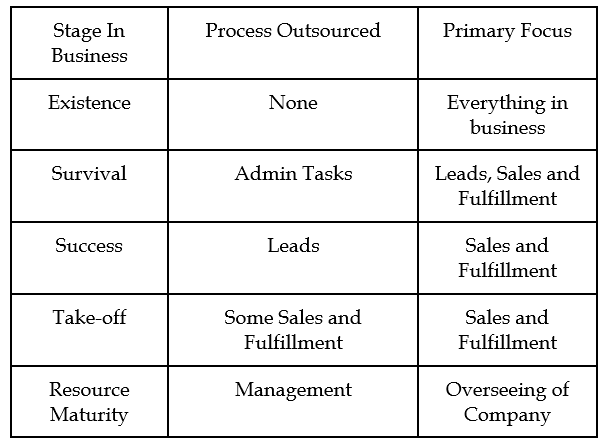Excerpted from Limitless Expansion Secrets: LES because we all want to work less by Trey Carmichael (Author), Kyle E. Gese, Justine Mader, Ariel Szilagyi, Robert Segelquist, Ashley Gunther, Bryce Vance, Andrea Adams-Miller, Andrew Napier, Richard Kahanek
So, by now, you’ve got a pretty good grasp of the foundations of beginning the expansion of your business. But how do you create a million-dollar business? We’re going to cover that right here! Beware: I like to use analogies to really drive points home.
Q3 2020 hedge fund letters, conferences and more
Mindset
Everything starts with mindset. What is the mindset of the owner of a 7+ figure business? That depends. Mindset is heavily influenced by past experiences. For some, it’s harder to develop a positive mindset due to negative past experiences. So how can you develop that winning entrepreneurial mindset?
It’s important to understand one major key factor to success. It takes the average entrepreneur seven tries in business before success happens. This doesn’t mean that seven is the ‘magic’ number. Some people get it right away and others can take twenty or more tries before they achieve success.
The qualities that a successful entrepreneur will have are:
- Positivity
- Creativity
- Persuasion
- Self-Motivation
- Tenacity
- Curiosity
- Flexibility
- Ownership
- Receptivity
- Passion
- Vision
- Self-regard
You’ll notice that out of these twelve qualities, eleven are directly related to mindset. Only persuasion, convincing others of ideas and solutions, would be considered a skill. However, even this is indirectly related to mindset since it requires you to truly believe in your product or service.
How do you acquire these qualities? There are several methods for developing them. There are different methods for different people. You shouldn’t just try a method that you read about. You should make sure that the method aligns with your personality. It’s also important to identify the areas that you need to improve the most and work on those the hardest. To get a head start, you can give these techniques a try!
- Acknowledge and embrace your imperfections. If you hide from your weaknesses, you’ll never be able to overcome them!
- View challenges as opportunities. A challenge is really just a chance to improve something, after all.
- Know your learning abilities. If you’re a visual learner, auditory learning might not be what you need to improve.
- Replace the word ‘failing’ with ‘learning.’ Every failure is a learning opportunity.
- The only approval you need is your own. Don’t seek approval from others. Push forward.
- The process is more valuable than the end result. Take time to appreciate the process of getting to your next destination!
- Know your purpose. Yes, it can be tricky, but when you understand this, you’re able to break free of constricted thinking!
- Take all criticism as constructive. Even when it isn’t intended to be.
- Effort is more important than raw talent. Raw talent only goes so far. Cultivate your skills and never stop improving.
- It’s not impossible. It’s just not within reach ‘yet.’
- Each goal achieved should be replaced with another. Consider short term goals ‘milestones.’
- Don’t be afraid to take risks. However, make sure you weigh your options.
- Take responsibility for your actions. If you’re constantly blaming others for negative consequences, you’ll find it difficult to get out of your own way.
- Everyone says, “think outside the box.” Instead, adopt this approach. “Think like there is no box.”
There are many ways that you can achieve the mindset of a successful entrepreneur, so look for courses and coaches that can help you in this area! It will probably be the best investment in your business that you can make!
Flexibility In Your Business Plan
Unplanned things happen. Get over it. Big deals fall through, a tragedy occurs, the market crashes, etc. Your business plan needs to be strong enough that it provides direction, but also flexible enough to bend with circumstances. Consider the biggest bridges in the world. How do they stay up? How are they able to withstand earthquakes and hurricanes? They’re sturdy, but also flexible. How does this apply in your business plan? If you’re so focused on the business following a certain path, you’re not only likely to fail when things go wrong, but you’ll also miss out on opportunities along the way, which can stunt the business growth.
Take Covid-19 for example. When the pandemic hit, many restaurants went under. Others flourished. Why? The restaurants that failed did not get on the online order or delivery train. The ones that stayed open made these changes as quickly as possible and were able to come out on top.
When you’re creating your Standard Operating Procedures, you want to make sure that you leave room for the unexpected. When the unexpected happens, you want to make sure that you document the steps you made and keep them for future reference. Make sure that you can adapt and overcome any situation that you’re faced with.
Budgeting and Finances
Look, I understand that financial basics are covered in this book, but there are a few things that you really need to understand if you want your business to hit 7 figures.
Understanding your numbers.
- Cash Flow - If your business is bringing in more money than it spends, you’re in pretty good shape. You want to make sure that you’re operating efficiently and that your expenses are justified properly. If you’re regularly spending more than you’re making, then you definitely need to reevaluate what your expenses are and look into eliminating wasteful spending. Your price point may also need to be reevaluated. Your net income and Profit & Loss Statements will also align with your cash flow and will help you identify corrective actions.
- Sales - Of course, sales are the lifeblood of your business. When your sales suffer, so does your business. Understanding if there’s a season that your sales go down or up will help you become more efficient in several of your processes. If your sales go down during the holiday season (as most high-ticket services do) then you’re able to plan for that. For example, you may only take calls from prospects that are ready to buy and schedule the rest for after the holiday season. You may also use this time to establish rapport with your prospects by changing your selling process.
The bottom line, if you understand your numbers, you’re more likely to understand if corrective actions are needed.
Processes
You should always be improving processes and procedures with the assistance of metrics. Split testing shouldn’t only be in regard to ads and landing pages, but also with your prospecting processes and cadences. It should also be implemented in the fulfillment of your product or service. Make sure you listen to your customers and clients to improve. Their feedback is what will help you create more offers and improve existing products and services.
Outsourcing
Outsourcing will possibly make the biggest impact on your business. What do you spend your time doing in your business? Where is the value?
Time is money. However, you don’t have to trade your time for money. When you have an adequate cash flow, trading money for other people’s time is what will ultimately take you to the next level. I know what you’re thinking, “I can’t trust anyone to handle my business operations!” Okay. That kind of thinking doesn’t allow for a business to scale. If you can’t change this mindset, understand that your business will likely not grow, and if it does, it will consume your entire life.
When your business is already established, identify the actions that you take in your business that make the most money. Then focus on those. The rest, you should outsource.
Over time, you’ll be able to outsource multiple operations and scale from there. Here’s a sample of how this should look. Remember this is only an example and there are a lot of variables involved depending on your business type and strategy. This example can be tailored to a new, single person electrician service that doesn’t have a whole lot of capital. Put yourself in the shoes of this person.
Existence Stage
In this stage you’re just getting started. You need to focus on making money. Invest in some business tools that will help you to get and organize your leads, document SOPs and help you with accounting. These will include:
- Client Relationship Management.
- Accounting Software.
- Ad robots that help you automate your advertising efforts and track metrics.
Remember that this example doesn’t have very much capital to begin with, so you must make sure that you’re making every effort to save money and get leads rolling in at the same time. A business with a substantial amount of startup capital will be able to invest a bit more into getting leads for their business.
Even at this stage, you should remember to keep your business and personal finances separate. In some cases, this is easier said than done, but if you want to grow your business, this will help you to keep track of your expenses and income. If you mix the two, you’re likely to get to the survival stage, and stay there.
Survival Stage
At this stage in your business, you’re maintaining your leads, but you need some help. Your phones are ringing more frequently and if you let the calls go to voicemail (due to being on a job), your customers will likely go somewhere else where the phones are answered. You want to have someone on hand to answer the phones for scheduling sales appointments and jobs along with minor admin tasks. This can definitely create a growing pain if there isn’t enough cash flow. Outsource this to a virtual assistant that can handle these things for you if you don’t have enough cash flow to bring a person in house.
Success Stage
When you’re at this stage, things can get a little tricky. You now have leads rolling, but you’re still spending a lot of time creating ads and running campaigns that may be working, but you can improve. Hire a marketing agency that can run this for you, saving hours in content creation and also improving the effectiveness of your ads. This allows you to drum up business without spending hours focusing on tweaking ads. You can bring in someone to be in-house, but that’s typically much more expensive than hiring an agency to fulfill this for you. They’ll have copywriters, graphic designers and experts in the market that can split test everything for you to make sure you’re getting the most out of your ad dollars as possible. This allows you to focus on sales and fulfillment of your service.
Take-off Stage
Here’s where it starts to get even better! At this stage, you’re able to bring on other electricians that aren’t necessarily interested in starting their own business. You start with adding another electrician. You already have the leads rolling in, so you need to be able to handle them. You train the new person to perform the sales operation as well as make sure they can handle the electrical work involved with considerable skill (after all, your reputation is on the line!).
Then, you continue to grow, when leads can be handled, you can pour more into your marketing budget and hire more electricians. This shouldn’t be done all at once. This should be done in steps. If you hire new people before you’re ready, you’ll be throwing money down the drain. Likewise, if you invest more into marketing, you’re likely to miss leads, and your reputation suffers.
Everything should be carefully planned and considered before making a move to invest more into marketing or hiring. You may even need to hire an extra person for taking calls and scheduling! There will be growing pains, and this is completely normal. Just make sure you can sustain the growth. Your profit margins will go down, but your volume will go up and it will help you make more money over time.
Resource Maturity Stage
Now you’ve made it. You’re now overseeing the business, without necessarily taking part in it. At this stage, you have one job. Keep the bottle necks clear. Focus on solving problems and creating better processes. Instead of working in your business, you now get to work on your business. Making sure you manage resources properly and you’ll create a bigger company that runs smoother over time and also increase profit margins!
Obviously, this is a super lite example that applies to a handful of industries. There are many things that go into each stage and different strategies that can be implemented with each different business model or industry.
Sales
Everyone knows that without leads, you have no sales and without sales, you have no business. Many different industries have different sales methods that work the best with their respective industry. I also believe that personalities play a major role in how well you perform at sales.
Too many people are getting the leads, but they aren’t closing the deals! Others close 10% of their deals and say, “well, sales is just a numbers game after all.” Is that true? Of course it is ... to some extent.
Consider two companies that are selling the exact same service at the exact same price point. They both set and keep 100 sales calls per month. Company A closes 10% of their sales, and Company B is closing 25% of their sales. Which company is making more money? Obviously, it’s Company B.
This tells me Company B is clearly following a better sales model than Company A. Which company would you want to own?
Sales is a very broad topic, and there will be various methods that work for different industries. It’s a lot to cover in a small section of a book, but there are some aspects that will go with almost every method. Here are some of these aspects that will help when designing (or improving) your sales process.
Understanding Your Prospect and Communicating Value - Most of the sales ‘gurus’ will tell you that benefits, not features, sell. They are absolutely correct. However, there is a bit more to this. People buy based on value. Out of the benefits that you provide, which ones do your prospects value the most? Find this out when you’re in discovery and build on it. Also, make sure that if it’s a set meeting, you should research your prospect so you can better understand what they value and what their personality looks like. Also, refer to them by name often.
Closing the Deal - Too many entrepreneurs and sales reps have a problem with closing the deal. They suffer from stage fright. The biggest factor here is asking for the sale. Depending on the prospect, you may want to ask for the deal in different ways. Using the assumptive close, the suggestion close, or the urgency close, etc. can help you close more deals.
Handling Objections - Almost everyone will have some sort of objection when it comes to closing the deal. There are different ways to handle objections. You want to have your sales process standardized so that you can overcome objections more effectively. Here’s a simple objection handling formula to document your process.
Acknowledge the Objection + Connect + Progress
Acknowledge the Objection - Always reiterate the objection back to the prospect. This tells them on a subconscious level that you are listening to their problem, and that you care about them, which also builds rapport and earns trust. Example: “It’s a lot of money.” - “I completely understand that this is a very big investment in your business.”
Connect - Here, you want to bridge the gap between their objection and your solution. Example: “and some of our current clients had the same perception at first, but once they realized that the investment paid for itself over time by eliminating x expense, and reducing y expense, they were able to justify making the decision to invest in our service.”
Progress - You have to remember to continue the conversation by asking a question. This question should be open ended to really make your prospect think about what you’re asking. A closed ended question can prompt a mindless ‘yes’ or ‘no,’ and not really drive the conversation. Example: “Let me ask you this. How would you feel if you can save $x per year, while growing your company more efficiently?”
These are just some of the techniques that you can use to improve your sales process and it is far from complete. Never forget to always keep improving over time!
The Takeaways Of Creating A 7 Figure Business
Here are the takeaways of creating a 7-figure business.
- Be flexible in your business strategies.
- Know your numbers.
- Always be improving in your business and sales processes.
- Outsource when you’re ready to help you focus on money making actions.
- Work on your mindset constantly to get where you want to be.
Remember, this is just a super lite guide for scaling your business. If you want more strategies for building and scaling your business, join Trey’s group and also join Elite Business Masters at elitebusinessmasters.com. Join these groups to get free strategies and business tools to use to skyrocket your business and meet new people!
About The Author
Richard Kahanek is a serial entrepreneur and private consultant that enjoys everything in business. Richard enjoys helping companies reach their goals and increase the effectiveness of their processes and operations. A sales enthusiast, he enjoys helping others increase the effectiveness of their sales processes and showing people how to sell while remaining true to themselves. Fancy getting in touch? Join www.elitebusinessmasters.com, absolutely free. You can talk to and interact with him there as well as get his contact info!







